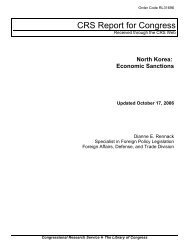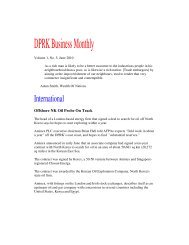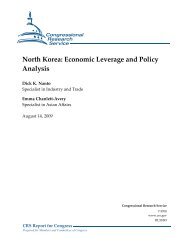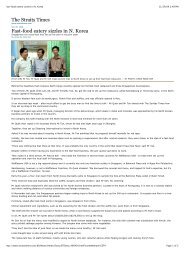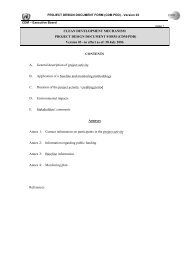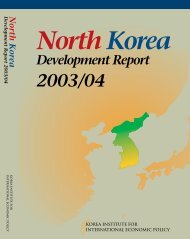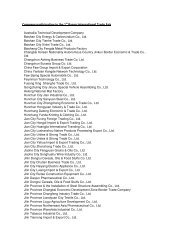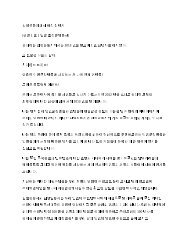North Korean Policy Elites - Defense Technical Information Center
North Korean Policy Elites - Defense Technical Information Center
North Korean Policy Elites - Defense Technical Information Center
Create successful ePaper yourself
Turn your PDF publications into a flip-book with our unique Google optimized e-Paper software.
personal apparatus. The source of much speculation by <strong>North</strong> <strong>Korean</strong> watchers, Kim Chong-il’s<br />
personal secretariat wields influence by virtue of its “gatekeeping” function. 23 Often compared to<br />
the royal order system that operated during the Chosun Dynasty (1392-1910), Kim Chong-il’s<br />
personal secretariat has no official sanction and rarely is mentioned in the <strong>North</strong> <strong>Korean</strong> press. It<br />
receives, classifies, and facilitates documents addressed to the chairman (Kim Chong-il) and then<br />
issues instructions. It also administers Kim’s schedule, itineraries, protocol and logistics supply,<br />
and liaisons with the Guards Command to ensure his security.<br />
Closely associated with Kim Chong-il’s personal secretariat (and even overlapping at<br />
times) is an entity known as the “Third Floor.” 24 This element of Kim Chong-il’s personal staff<br />
assists him in conducting numerous “special” operations, both inside and outside the country.<br />
The members of the “Third Floor” cadre normally have long political lives. Paek In-su (former<br />
head of Office No. 39) worked for the apparatus for 28 years, while Kwon Yong-nok and Yi<br />
Ch’ol worked for more than 20 years. While it would be difficult to replace them, as they are in<br />
charge of secret affairs, their long hold on their positions is also not unrelated to Kim Chong-il’s<br />
personality. These behind-the-scene members of the leadership are critical to the maintenance of<br />
the regime.<br />
These “special” operations mark a significant departure from the role of the personal<br />
secretariat as it existed under Kim Il-sung. For example, the concept of a slush fund, which is<br />
managed by Kim Chong-il’s staff, did not exist. Instead, Kim Il-sung’s needs were paid for by<br />
“presidential bonds,” which were created by laying in three percent of the budget. They were<br />
akin to the resources reserved in preparation for war. 25 These secret funds are Kim Chong-il’s<br />
personal money for him to buy whatever he thinks is necessary, including daily necessities from<br />
foreign countries or presents for his subordinates. In terms of system dynamics, the operation of<br />
this nefarious activity by a key component of the regime undermines Kim’s legitimacy.<br />
23 According to some sources, the secretariat was created in the mid-1980s, when Kim Chong-il carved out its<br />
responsibilities from the KWP CC, most likely from several departments, including the General Affairs<br />
Department, which oversees a variety of housekeeping functions for the party leadership.<br />
24 The name comes from the location of this office, which is on the third floor of Office Complex Number 1, where<br />
Kim Chong-il’s offices are located.<br />
25 U Chong-ch’ang, “ROK Monthly on DPRK Kim Chong-il’s Slush Fund Deposits in Swiss Banks,” Seoul, Wolgan<br />
Choson (November 1, 2000), FBIS translation KPP20001019000046.<br />
II-20



